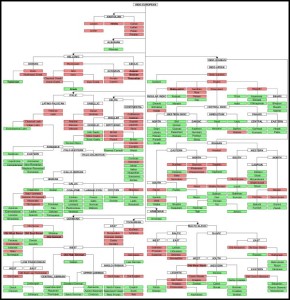Contemplating a Curriculum for Human Languages Literacy, Part 4: Languages change over time – sometimes systematically, sometimes arbitrarily
This blog entry is the fourth (4th) in a multi-part series describing what a curriculum for human languages literacy might look like.
C
Most people tend to think of languages as relatively static. And they are…for about 3-5 seconds at time. 🙂 In reality, languages are constantly changing for several reasons. For one, new words are always being added to the set of acceptable words in every society. Some of this is because of developing technology. But even without advances in science and technology, new concepts, associations and circumstances are always coming about that need words to describe them. This has been true for millenia. Sometimes these new terms stay local to a subgroup of people and are not widely accepted. But other times they are adopted among the general public and eventually make it into a publisher’s dictionary, or in some countries, into an official state-sanctioned lexicon. The opposite phenomenon can also be true. That is, words can fall out of use. For example, an item may no longer be used much and is more or less forgotten or a particular trade may no longer be active.
Another reason languages change is due to influences from other languages. This can stem from such things as new trade relationships or from a conquering entity taking over a new territory. The changes could be tied to vocabulary or grammar or pronunciation.
A single language might change in one manner in one geographical region and in a different manner in another region. Eventually, one of the groups using a language apart from the others develops a distinguishable dialect. Then, in time, usually measured in centuries, that dialect might transform into a new, different language. For example, so-called “romance languages” French, Spanish, Italian, Romanian and Portuguese all came from Latin. Arabic has more than ten (10) different dialects, some of which may become new languages at some point. And Chinese is really more a group of languages, some of which are unintelligible to each other despite their common roots.
The tree diagram in the graphic above on the right shows just one example of historical development of what are now called Indo-European languages. You can download a PDF of this tree diagram to see more detail here: Indo-European Languages Tree (PDF).
Most of the language change discussed so far is relatively systematic and traceable based on understandable influences. However, languages sometime change for arbitrary reasons. Particular words from one language may be borrowed while other related words in that language aren’t. Words are sometimes chosen by mimicking a natural sound (onomatopoeia), sometimes from a combination of two words in the language, sometimes reclaimed from an older version of the language and sometimes, well, just because.
There are two take-aways here:
- when learning a new langauge, it is important to know how language is currently being used and which regional dialects are in active use, and
- understanding how words are formed or where words are borrowed from can give you a head start in analyzing and remembering those words.
Coming next: Being multilingual has “multi-benefits”
Historically yours,
Mike
(Mike’s bio)
P.S. Your critiques or affirmations are always welcome! You may comment publicly below or contact me privately on the contact page.


Leave a Reply